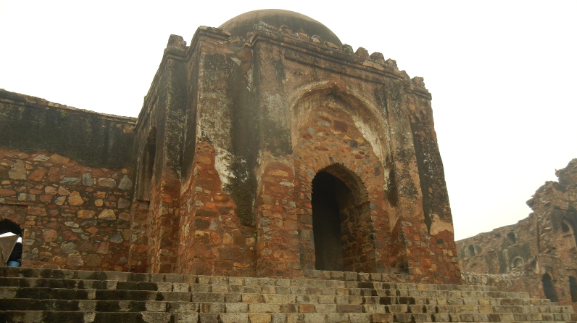The Explorers | Lodhi Art District
Janhavi Sharma, Young India Fellow’ 2020 In the midst of the hustle and bustle of the city of Delhi, lies

Nishka Mishra, Undergraduate Batch of 2022
“The spirits had seized my house. They claimed my mother’s life and, my father followed next. I would have been next, if not for my uncle. He brought me here and, they saved my life. They exist madamji, and they’re always watching,” he answered as he directed the newcomers to the inner entrance. I’d asked him if he genuinely believed the existence of djinns to be true.

Never in my life had I imagined that I would, one day, be walking towards a dungeon asking a devoted guide about djinns. Muslim mythology describes djinns as supernatural creatures who possess free will to do good or evil and the ability to interact with humans. However, up until then, talk of djinns and genies would always conjure up a limited number of images in my head. They would range from Will Smith dancing to Arabian tunes in Aladdin to blue wish-granting beings emerging out of a golden lamp. However, a visit to this mahal sitting right amid the hustle-bustle of Delhi changed all that.

The Djinn Mahal, a fortress also known as Kushk-I-Firuz, was built along the banks of Yamuna as the citadel of Firuz Shah Tughlaq in the 14th century. At its highest point of glory, this citadel consisted of palaces, pillared halls, mosques, a pigeon- tower and a baoli until Firuz Shah’s entire city was robbed to build Shahjahanabad. Despite its crumbling architecture, the place is visited by hundreds every Thursday to worship the djinns and conduct rituals. People all around the city know this place for its haunted yet magical nature, unaware of all the stories hidden in the fixtures and all the myths visitors have believed to be true.
Upon entering, one immediately notices the stark difference in the atmosphere. A mysterious and eerie silence quickly replaces the assortment of noises coming from the vendors and traffic. Families talk in hushed tones as they walk towards the three-storeyed rubble structure with multiple photocopies of their unfulfilled dreams.
“The djinns will fulfil your wishes. All you have to do is write them on a piece of paper and tape one paper in each of the 40 dungeons present on the first level. They come and read them after the sun sets, and if they find your wish to be true enough, they will grant it.” the guide told me.
The practice of writing petitions to saints and rulers was well prevalent during the period of the Delhi Sultanate. This has simply been carried on to this date in this citadel with saints being replaced by djinns. According to Islamic texts, djinns were created in a manner different from humans, still, they reside alongside us on this planet. While they are considered to be powerful entities who can grant wishes, they are also said to be capable of punishing those who anger them.

A narrow and winding staircase with broken steps led to the second story of the structure. Amongst the rock pillars, I came across a man on his knees trembling and uttering incomprehensible sentences. There were people gathered around him and one man stood in front of him, chanting a prayer over and over. It was quite a disturbing image to watch. I was later informed by a local that the man was possessed and that the djinns would help bring him back to his original state. “The man who is chanting can speak to the djinns. Those who read the namaz five times a day can mediate on behalf of the possessed people,” the guide told me. When I asked him about spirit possession, he told me, “There are bad spirits that can enter individuals and cause them to go down the wrong path. Coming here seven days in a row will give them the healing they need. They must put up those letters and offerings to the djinns. If the person still isn’t healed, there’s a mahal in Kashmir where they should go.”
“Why should they go to Kashmir?” I questioned.
“The djinns there are much more powerful. They have the power to heal better than the djinns who stay here,” he answered.
Another staircase leads one-up to the last level of the structure. At the very top of the building lies the pillar of Ashoka that runs 13 meters high and has writings engraved on it. Writings across the location describe how the pillar was brought to Delhi by Feroz Shah with great effort and then reinstalled. Legend has it that the ‘Sarkar’ or the chief of the djinns lives there and if one can touch the pillar from the railing, their wish would be granted.
The citadel closes entry to visitors after sunset as it is considered dangerous to be present amongst the spirits at that time. The fortress did not, however, develop such magical and spiritual connotations until much later after its existence. Research had revealed that the ruins came to be associated with such beliefs after 1977 when a fakir began to reside nearby and worshipped there with his devotees. The rich history of the location was soon entwined with the spiritual status. The presence and worship of djinns have labelled this area as one of the most haunted ones to outsiders. However, to the locals who come to seek help, the djinns are merely invisible beings of hope in their world where everything is so visibly painful.
The author is a Staff Writer for the Arts and Culture Section of The Edict